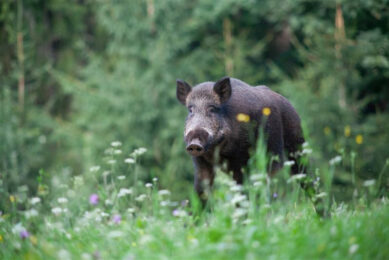High cereal prices II
In my last blog, I discussed non-nutritional ways of addressing the problem of high cereal prices. Now, it’s time for nutritional suggestions. After all, feed used to make up at least 60% of the cost of raising a pig. Now, it is even higher!
In my last blog, I discussed non-nutritional ways of addressing the problem of high cereal prices. Now, it’s time for nutritional suggestions. After all, feed used to make up at least 60% of the cost of raising a pig. Now, it is even higher!
So, to start with, the general idea is to improve the feed-to-gain ratio, or feed efficiency. Anything that reduces the amount of feed required per unit of weight gain is reducing feed cost per unit gain! Here is a list of my suggestions for your consideration.
Grind cereals finer
It has been determined by pioneering work done at Kansas State University by Dr Joe Hancock’s laboratory that for every 100 microns reduction in particle size, feed efficiency improves by 1.4%.
As an example, assume that you grind your cereals at 900 microns (medium-coarse) and you achieve a 2.9 feed/gain ratio in the finishing barns. If particle size is reduced to 600 microns, feed efficiency is expected to be improved by 4.2% at 2.68.
Of course, this improvement in feed efficiency should not be outweighed by the cost of grinding cereals to such reduced particle size!
Consider enzymes
Here, I am considering enzymes against the major non-starch polysaccharides found in cereals, especially in wheat (arabinoxylans) and barley (beta glucans). Data for maize-based diets are unclear, at best!
But, for diets based on wheat and barley, particularly if these cereals are of poor quality (as defined by a large concentration of non-starch polysaccharides), the addition of a cereal-specific enzyme should increase metabolizable energy concentration by about 50 kcal/kg complete feed.
Effects on protein digestibility are not so well documented, so it’s recommended to base your calculations on energy savings alone. Again, the cost of using such an enzyme should not be outweighed by the cost of providing a similar amount of energy through other sources (lard, tallow, soy oil, etc).
Neutralise mycotoxins
Pigs invariably suffer from lower performance when fed diets even with low levels of mycotoxins.
It is best to determine the predominant mycotoxins for the cereals you use and then apply a specific product, instead of using a blanket approach that usually costs more and does not cover region-specific mycotoxin problems.
For example, maize from the Americas is often contaminated by aflatoxins, but maize grown in Europe usually suffers from a host of totally different mycotoxins!
Balance diets
This is easier said than done as it requires the use of a growth model to compare nutrient requirements versus nutrient supply. And, this is the first step!
Then, a qualified nutritionist is required to assess the changes needed to match the two together in an effort of cutting cost by reducing excesses, covering deficiencies, or preferably both. INRA (France) has recently released such a growth-nutrition model (InaPorc), which appears to be quite promising, especially in the hands of a qualified nutritionist!
Pelleting?
Yes, pelleted feed is most likely to improve feed/gain by 5 to 15% depending on diet nutrient composition, ingredients used, and of course, the weight class of the animals.
For example, greater improvements are expected in younger animals. As always, the extra cost of pelleting should not be greater than expected benefits, especially now that the price of fuels is extremely high!
Cereal alternatives
Usually this is the first solution that comes in mind when cereal prices go up. But, unless you lock in a large quantity of such alternatives before the market adjusts, it is highly unlikely such ingredients will remain price competitive for long.
It is a fact in economics, when the prices of reference ingredients increase, the prices of alternative also increase just below the point where the use of the such alternatives is no longer financially rewarding.
Based on current market ‘intelligence’, I believe we have already reached such balance, so cereal alternatives are not so attractive anymore.
But, as I constantly receive a number of requests about them, I think it is best to talk about alternatives more extensively in the next blog!











